https://www.youtube.com/watch?v=htiBnJTP6gw
9 Ways To Use Your Queen Effectively In Chess

Hey guys in this video , we're looking at nine ways , you can use your queen more effectively .
Now , before I get into that , I want to just mention I do have my next over the board tournament coming up later this week .
So stay on the lookout .
Those video recaps will be coming very soon and hopefully I can do better than last tournament for those of you who saw those videos , you know , didn't quite go as planned .
I lost about 40 points .
So , uh we'll see if we can do any better , but that's coming .
Uh Having said that though , let's go ahead and jump right into how to use our queen , right ?
So when it comes to the queen , we gotta have a similar situation like we had with the rooks , ok ?
The queen is a very valuable piece and if you bring the queen out too early , like some people like to do , you can get into trouble .
Now , of course , because it's such a powerful piece .
Can you get quick , you know , checkmates and win some pawns here and there ?
If your opponent doesn't know what they're doing , of course , there's a , you know , there's this little trap where you can win their rook or there's the uh the famous four move checkmate right where your opponent doesn't see what's going on and you just win four moves that can happen .
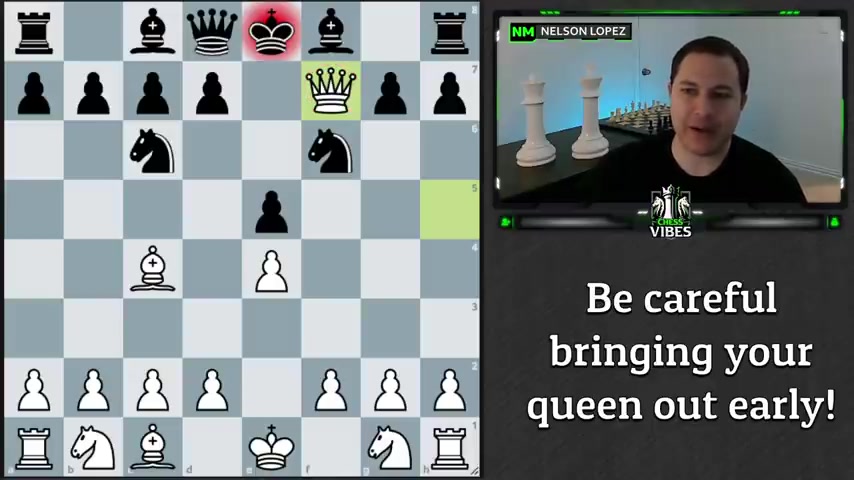
But once you hit a certain level , I think it's around 800 to 1000 .
When , when players start to understand how to stop this and what to do , you're gonna be just setting yourself up to get into bad positions .
OK ?
And it's the same reason that we talked about with the rook .
The queen is a high valued piece .
So , um if your opponent knows what they're doing , they're gonna play G six and guess what ?
You have to move it .
And then if you can come back here , they're just gonna develop their pieces and your queen , it ends up just being a target , right ?
The knight can come in and harass it and then you have to move it and then this night maybe can go somewhere or the bishops can attack it and you really don't want your queen to be moving all around the board so early just wasting time .
So you have to be very careful bringing it out early .
Now that being said , there are some specific times that you do want to bring it out and things that you wanna be looking for , which we'll talk about later in this video .
But as a general rule , a lot of times it makes sense to get your knights and bishops out first and really wait for the right opportunity before you start to go for the queen .
Ok ?
Keep that in mind as we go through this list of nine things .
All right .
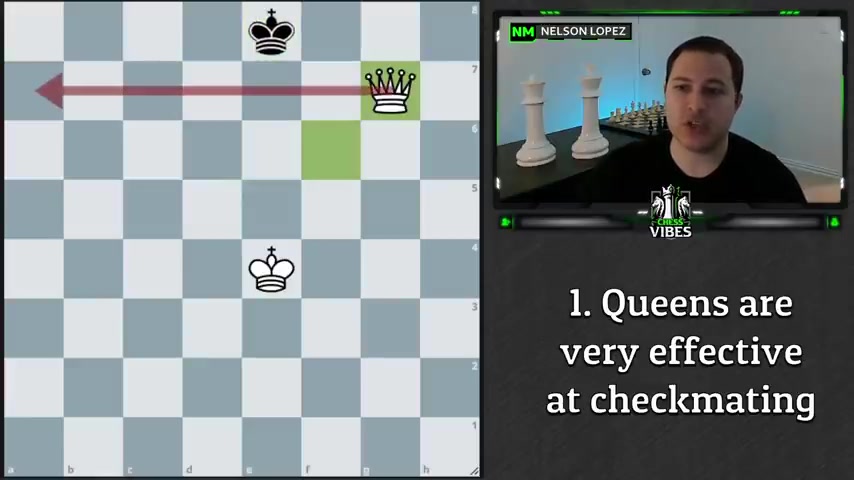
Number one thing about the queen is that it is extremely effective at check your opponent's king .
So this is one of the most basic endgame techniques that you learn .
You should probably learn when you first start playing chess , how to checkmate with the king and a queen against the king .
It's very simple .
You've got the box , you keep making the box smaller and smaller .
And uh eventually you'll get this position where the king is completely cut off on , on one rank and you simply um bring your king up , sorry , bring your king up and it doesn't matter where the king goes , you can get checkmate .
Now , this is at the end of the game .
But this concept , this idea that the , that the queen right next to your opponent's king , as long as it's defended will always be checkmate .
Of course , as long as nothing can take your queen .
In this case , there's no other pieces .
But this idea , you want to keep in mind if we go back to the start of the game here , uh what this means is our queen is very valuable and very powerful for that reason .
It's one of the best attacking pieces that we have .
So if you're trying to go for a check mating attack .
You need to make sure your queen is involved .
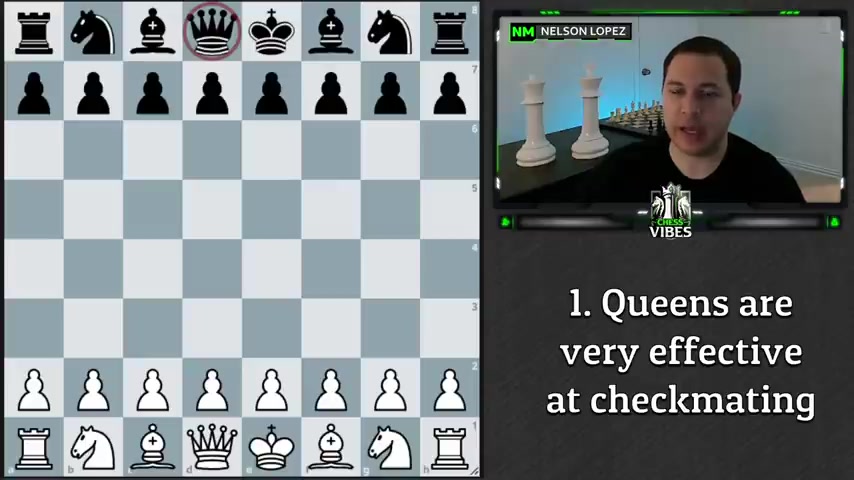
And at the same time , you have to pay attention to what your opponent is doing with their queen .
Because if it's coming towards your king , you're not prepared defensively , it's not gonna end well .
Ok .
So keep those things in mind .
Queens are extremely powerful and usually you just need one other piece to help the queen and you can get a very strong check mating attack , right ?
The second thing about queens that you want to keep in mind is when you are considering bringing your queen out somewhere , you want to ask yourself the question is this going to be a safe square for my queen or not ?
So for example , is queen H five A , a safe square for the queen .
Not really because the knight can go to F six at some point .
First block is gonna defend his pawn .
But at some point very soon the knight's gonna go to F six , chase your queen where you're gonna waste some time , right ?
So it's not really a safe square .
What about G four ?
Same kind of idea .
The knight can go to F six .
Even this pawn can come up , bishops attacking your queen .
You're gonna have to move .
Not really a safe square .
What about F three ?
It looks a little bit more safe , but it's really actually not a great square as well because after night of six .
This pond comes up , guess what ?
Bishop to G four .
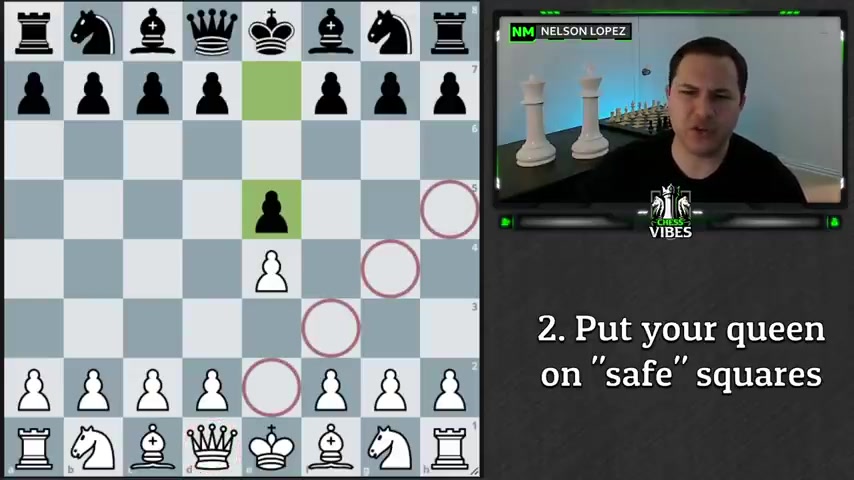
It's gonna be attacking your queen or 96 94 it's gonna be attacking your queen .
So really again , not really a great square and then Queenie two is probably safer , but you still have to watch out for this and it's blocking your bishop .
So that doesn't really make sense .
So , so in this position , there's not really any , I would say good safe squares for our queen .
So let's look at another example .
Let's say we play C 39 , C six and we're considering playing queen A four is queen A four , a safe square for our queen .
Well , I would say this is much safer than these other ones that we looked at because this night , first of all , can't really get to our queen .
Uh Not any time soon , right ?
It would take 1 to 3 moves and you can't even go there .
So I don't know something like this maybe , but that's a lot of moves and not gonna be easy for black to do .
Uh What about the bishop ?
Maybe D six , bishop D seven ?
But then we would have some time to react because the night would have to move .
So this is a much safer square than H five G four F three , in my opinion .
So these are the kind of things that you want to think through when you're considering .
Uh I'd like to move my queen somewhere you wanna ask yourself ?
Is this a safe square ?
Am I gonna be just wasting my time ?
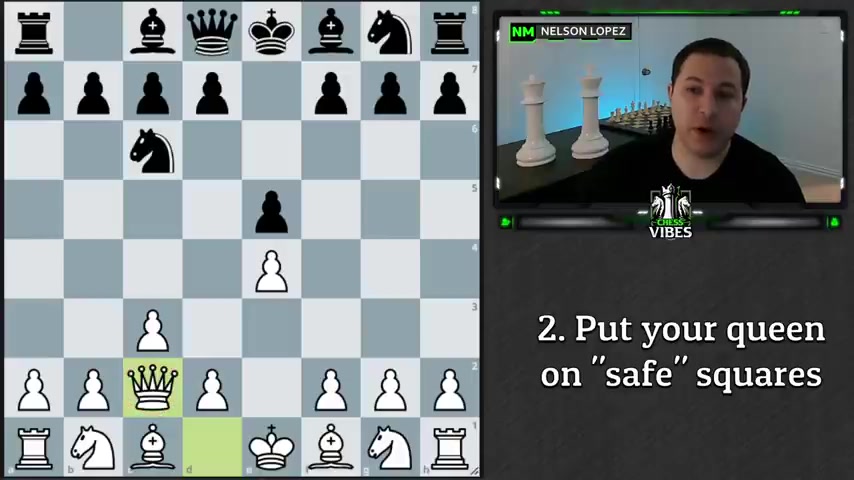
Right ?
Um What about C two ?
Is this a safe square for my queen ?
I would say , yeah , that's a pretty safe square because you've got the night dominated by this pawn already .
So you don't have to worry about that .
There's no chance that a bishop's gonna come here .
At least not right now because our , our pawn has got that diagonal closed off .
So that's a very nice square .
You don't have to worry about your queen getting harassed .
So I I , you OK with that .
What about B three ?
Is this the same square ?
Um You might notice that there's 985 .
So this one's kind of debatable because no , is not really safe .
But then also black putting their night on the edge of the board maybe is kind of a questionable choice and then we can just probably drop back .
And it's like , I don't even know if black really accomplished anything from that .
So uh in this position , I , I might be OK with queen to B three , right ?
So those are the things you want to think through which squares are safe and which squares are gonna cost you a bunch of time , right ?
So those are some kind of general uh ideas and concepts about the queen that you want to keep in mind , right ?
That it's very powerful .
It's very good at check painting your opponent's king , it's one of your best attacking pieces .

Um And you know , you wanna be looking out for safe squares , but now the next couple of items on the list are gonna be some very specific ways you can use your queen .
And I think you guys are gonna enjoy this .
So let's go to number three .
All right .
So for the third way to use our queen , I'm gonna give you an example first and see if you can spot the move and then we'll talk about the , what , what the way is ?
So this is the Sicilian .
This is actually a trap and we play C three .
OK ?
And after night of six , blacks attacking the po four , we can actually play the move bishop to E two and completely ignore it .
So the question for you , if you've never seen this before is why are we OK ?
Giving up our E pawn for free , what is our response going to be ?
Well , if you've had a chance to look at that and you're ready to see the solution .
The point behind this is that if black does take the pawn , we have queen a four check and we're forking the king in the night , we're winning our piece back , black has to deal with the check on the king and then we can simply take the night .
So we just want a piece .

Um So this is a , a trap like I mentioned but this idea of playing queen a four check and then potentially taking another piece somewhere along this rank is a good idea to keep in the back of your mind , right ?
Because sometimes there's like a random bishop over here or in this case , the night was on E four , like it happens in different ways .
But queen 1/4 check , keep it in the back of your mind and make sure if there's any pieces along this fourth rank , you watch out for it .
And this can go the other way too if you're playing as black .
And you're considering right AAA game like this where you're , I wonder if I should take that .
Well , always ask yourself what's gonna happen if my opponent brings the queen out and puts me in check .
Am I gonna get into danger ?
OK .
So keep that in mind .
All right , the next way you can use your queen is by attacking A B seven or G7 pawn um after the bishops have moved or even sometimes before the bishops have moved .
So here's an example this comes out of the French and this is the winner and one of the main lines is pushing E five C five and then you can actually play queen G four .
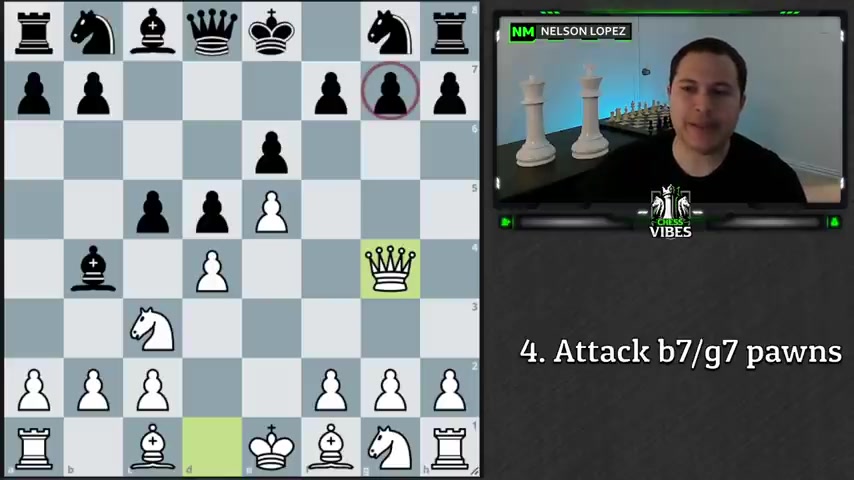
Now , sometimes this move will happen later .
I think the main line actually white delays .
But to illustrate the point , you can actually play queen G four now and we are trying to take advantage of the fact that this bishop is gone and this pawn on G7 is weak , right ?
So , um usually what happens in these types of situations .
First of all , if black , you know , doesn't know what's going on and just plays a random move like 96 or they're just losing , you just take it and the rook is trapped .
Ok .
So this is kind of a very basic thing .
You'll see it at the lower levels .
But uh you , you know , you just take the rook , right ?
But most of the time what's going to happen is players will realize what's happening and they'll do something like this , they'll move the night , they'll let you take it and then they'll slide the rook over and in this case , you can actually get another pawn .
Um But what happens is you lose some time , right ?
Because you spend 1 to 3 moves with your queen , black develops the knight gets the rook on an aggressive and active um file .
And so they actually do get quite a bit of compensation .
So you wanna be making sure you're , you're OK with that .
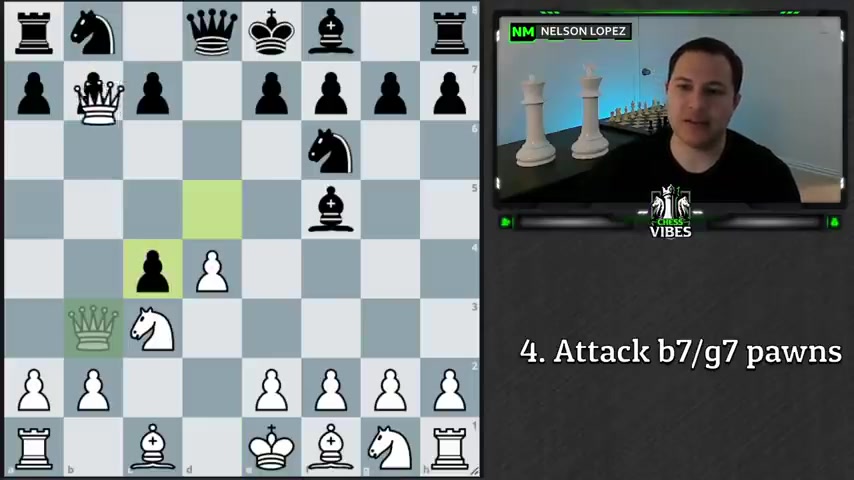
Now , this is definitely playable for , right ?
The engine actually likes black a little bit just because , you know , black has like three pieces out and uh we only have really the ninth .
But um this is kind of what you want to think through .
And so there's like I said , there are a couple ways you can do this , this example we saw queen G four .
This is pretty common in , in the French where this bishop comes out right away .
You'll see this a lot .
Um But let's go back and look at another example in queen's gambit types of openings .
Uh It's more common , let's just say , I don't know , black does something with the bishop .
It's pretty common when this bishop comes out that you'll see queen B three , sorry queen B three .
And again , it's the same idea , right ?
We're gonna try to go take this pawn if black lets us .
Now , of course , it's not that simple because black can move their , their night .
Like I said , the rook's gonna probably come over , put some pressure here .
So , you know , you have to think through that , but this is definitely something to keep in the back of your mind .
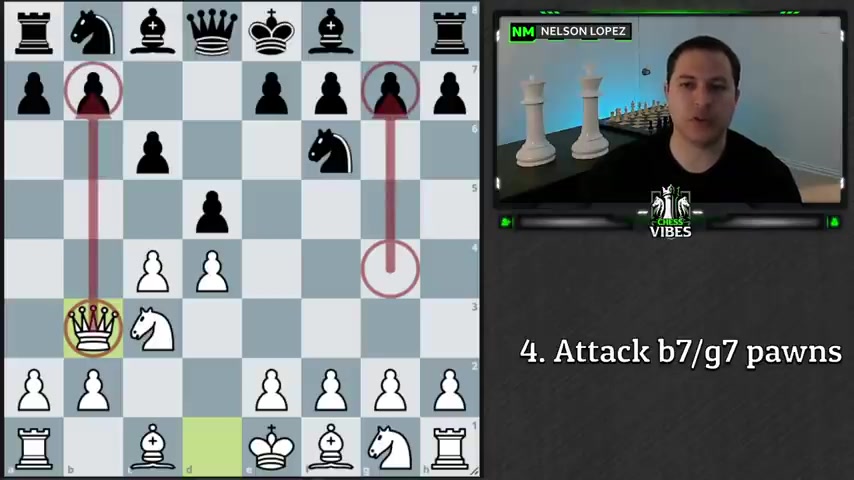
And sometimes what you can actually do is um play queen B three at some point to prevent the bishop from being developed , right ?
Because now if black tries to develop , well , guess what ?
We're just gonna take it .
So those are the kind of things you want to keep in mind .
Queen B three , queen G four in some cases to attack these pawns .
And of course , it works if you're black as well , same kind of thing on B two and G two .
All right .
The next way you can use your queen is by attacking the king with queen to H five .
Now , we've already kind of talked about why you don't want to do this right at the start of the game .
Yes .
Some people at the lower levels can get away with this little trick , you know , but once Black knows what they're doing , it's not gonna end well .
So you don't want to play that right away , but you do want to be on the lookout as the game progresses , especially of black castles .
Um Kings side , you wanna be on the lookout for queen H five .
So let me give you a good example .
So here's a position we can see black as castle kings side .
It's our turn .
We actually have a very strong move as white .
What do you think we should play ?
Well ?
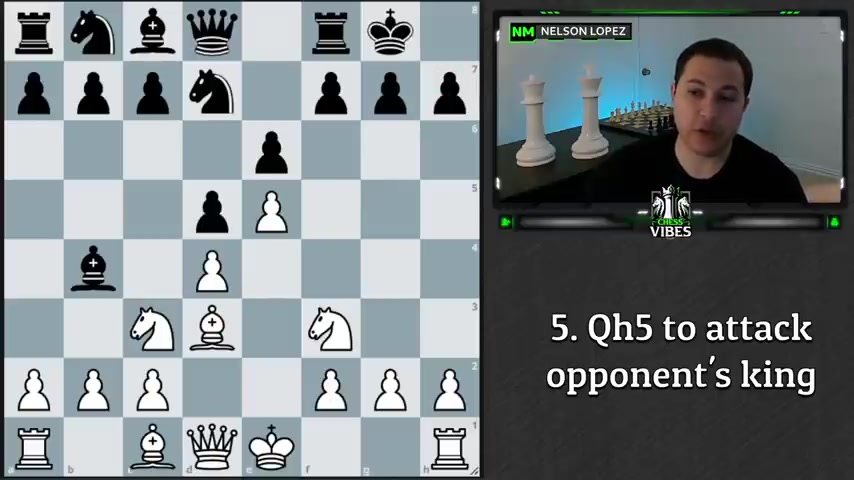
If you had a chance to look at that , the best move in this position is bishop takes H seven .
Now there's , there are actually a lot of good moves .
Nine G five is a strong move .
It gets ready to unleash the queen uh build the pressure with the night and that's not a bad move , but it's not as good as just simply sacrificing the bishop .
This is called the the Greek gift I believe , sacrifice where you give up this bishop for free .
And the point is that now we can follow it with nine G five check .
If the king goes back , we are setting up , remember queen H five , right ?
This is the , the move that I'm showing you .
And so now black is just getting mated or I , I think technically they could survive if they sacked the queen .
But I mean , you're just completely winning , right ?
And if they don't sack the queen , they can try to run this way , but it's not gonna help them because you can take here on F seven king goes over , check , check , check and mate .
Ok .
So , um , very , very common idea to keep in the back of your mind when your opponent castle king side is that the queen can come to age five .
But like we saw in this example , sometimes you have to set it up .
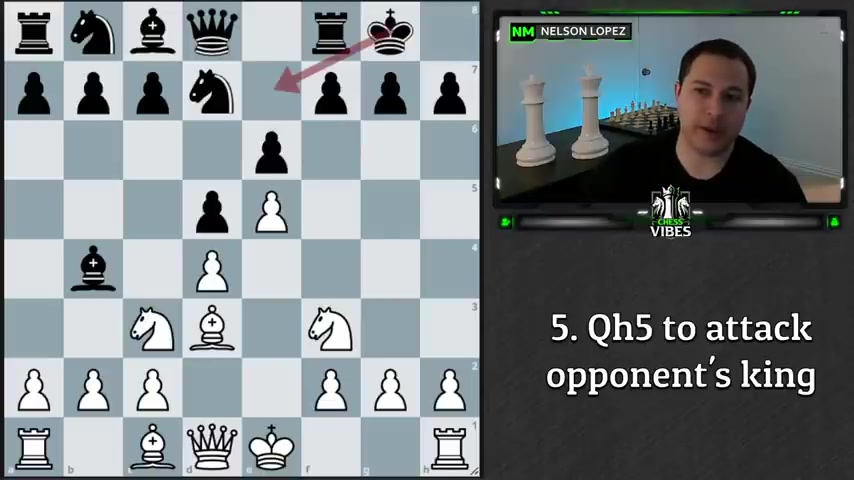
Sometimes it's not as simple as you know , move your night , move your queen and checkmate , right ?
You black is probably not gonna let you do that .
So this is a good example and one thing that's very important to note here um because Black's knight is not on F six , right ?
It was on F six .
We chased it away and it moved away .
That's when this opens up and becomes an opportunity for you .
So as the game goes on , if you ever see that um night on F six , either move away somewhere like in this case or if it gets traded off or if your opponent doesn't put it there , like if they develop the knight to E seven or , or something instead , that's when you want to keep an eye out for queen H five on the castle king , it's a very , very good way to attack .
And a lot of times we will lead to checkmates , right .
The next way to use your queen is to create batteries .
So remember , batteries are when you line up multiple pieces on the same file or same diagonal .
So the queen is capable of doing batteries with other uh bishops or with the rooks .
We're gonna look at some examples of the rooks in just a second .
But first , this is kind of one of the most common ways to create a very strong check pain threat .
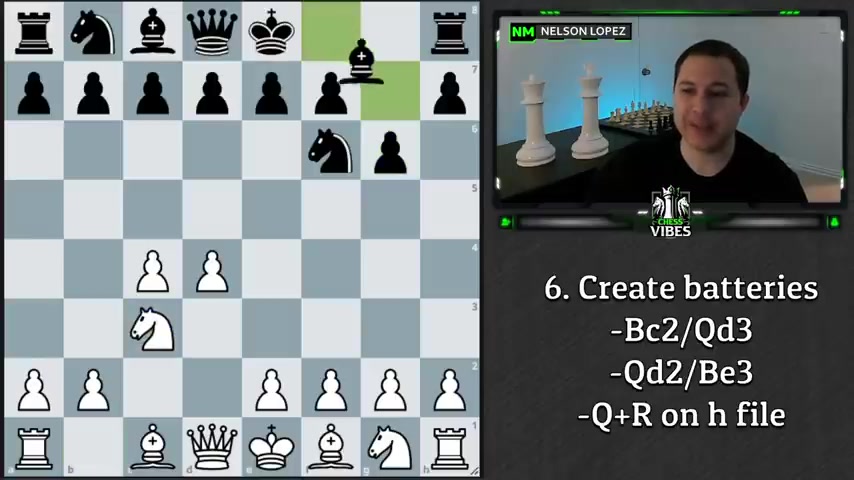
You bring the bishop out , you drop it back , you bring the queen up to D three .
And this is particularly useful when they castle kings side again , you create the checkmate threat on H seven .
I've talked about this before on this channel , but it's very , very difficult for Black to figure out what to do because if they just kind of ignore you , you're gonna probably play G four G five .
And once that night moves , this is , is checkmate .
If they try to stop it with like H six , it's , you're still gonna do that .
Create an open G file .
I mean , you can play H four .
There's a lot of ways that you can approach this .
Like if they play , let's just say G six , you can play H 4h 5 .
Um I mean , it's just very dangerous for black .
So easy way to create a check made threat queen to D three .
And another type of battery with the queen and bishop is when you're playing against a fee and kettle bishop that you're trying to get rid of .
So a good example of this would be the king's Indian .
Somebody plays the king's Indian against you .
You don't like dealing with that bishop .
What can you do about it ?
Simply put your queen on D two , put your bishop on E three , create this battery .
Go down there and trade it off .
So very simple and easy thing to do .
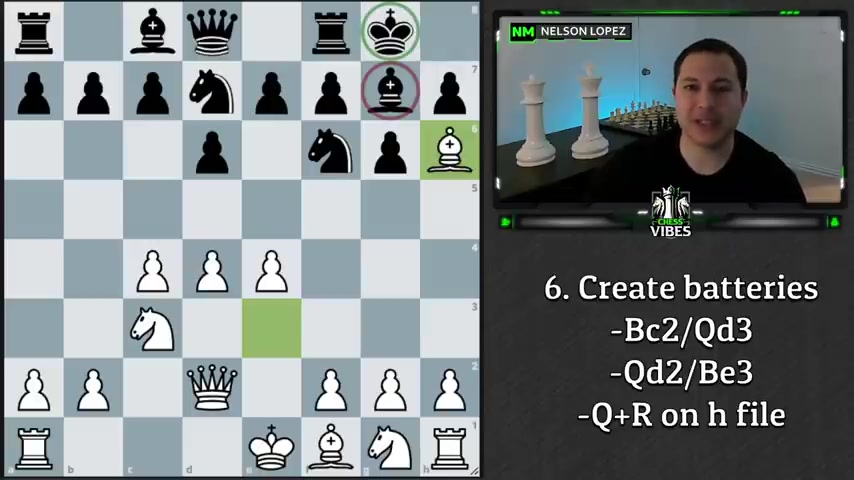
Get rid of that power for bishop , makes the opponent's king weaker .
Uh Because the bishop is not going to be controlling those dark squares and you can potentially take advantage of that at some point in the future .
Very easy thing to do .
Like I said , queen D two , bishop E three goes rate it off .
All right .
And the next example of a battery here is to create a battery with your queen and Rook on the open uh or a half open H file .
So this is kind of a trick question .
But what do you think the best move for white is in this position if you want to pause and think about it ?
And if you had a chance to look at that , uh the best move is actually Rook takes H seven .
So not queen H five , even though I just said , creating a battery the problem with queen H five is that uh black has bishop E four and it kind of just defends everything and now you're gonna have a hard time breaking through .
But what we can do is sacrifice the rook first and after the king takes now we can play queen H five check forces the king back and we make a battery using this rook .
Ok .
So we do still get the battery on the open um H file .
But now BB four doesn't do anything because we have checkmate .
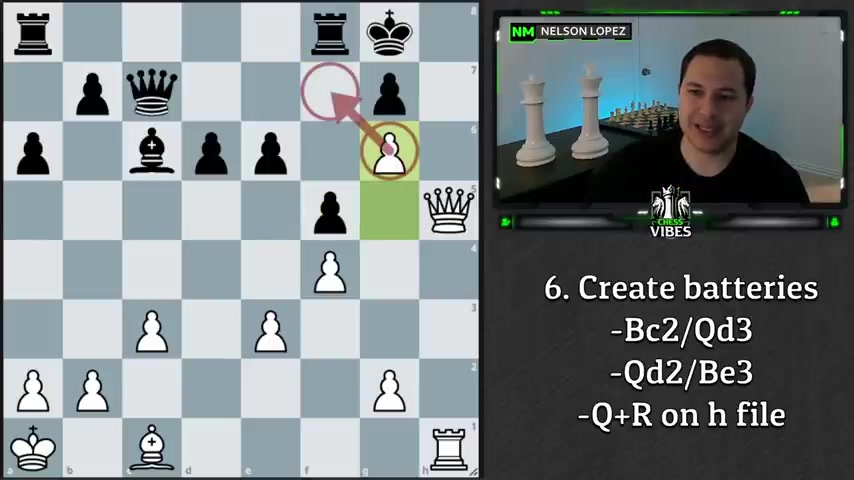
So the only thing black could try would be to like move this pawn up to try to escape this way .
But we can just play G six , keep the king box stand and there's no way to stop checkmate next move on H eight .
So um you know , but again , that started with sacrificing the rug just to open up the king , get that uh age file open and then using the queen and the rook to create the battery .
And , and once you get this kind of a setup , if blacks pieces are out of position , there's just nothing they can do .
Ok ?
So keep that in mind , use your queen to create a rook rook and queen battery along an open file like this .
All right .
And for the next way to use your queen , I have an example for you here .
It's white to play and win .
What should white play ?
I'll give you a second to think about that positive if you'd like .
And if you had a chance to look at that , the move is knight to D seven check .
And what we are doing is setting up a smothered checkmate .
And so the way that the queen is involved in the smother checkmate , here you go with the uh double check .
King has to go .
Uh You sacrifice the queen , right ?
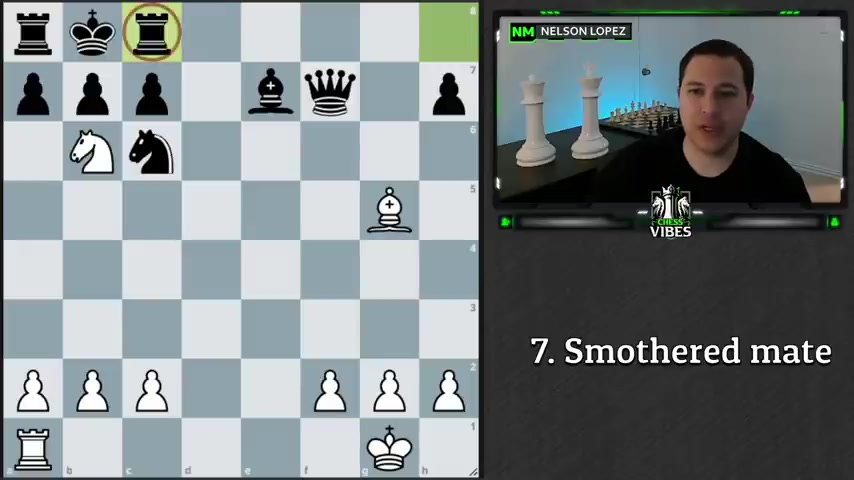
That's the whole point in these smother checkmates , you sacrifice the queen and of course , is defended by the knight .
So the king can't take , which means the rook has to take it .
And the reason you did that is to surround the king with their own pieces .
And then the knight comes in for the smothered checkmate .
So that's a , a good one to keep in mind and you do have to sacrifice your queen .
But this kind of brings me to the point , you can sacrifice your queen at these moments to set up checkmates and it's worth it because at the end of the day , you're just trying to get checkmate , right ?
The next way you use your queen happens a lot in end games , particularly when lots of pieces have been traded off .
So this position , black's completely winning has a lot of extra material is about to get another queen is about to get check made multiple different ways , but it's white's turn .
And so because of that white is able to come down and go for the perpetual check , back and forth , back and forth for three times and the game is just a draw .
And so keep this in mind when you're playing queen end games in , even if you're down by a significant amount of material , if you're able to find a spot where your opponent's king is not super well defended .
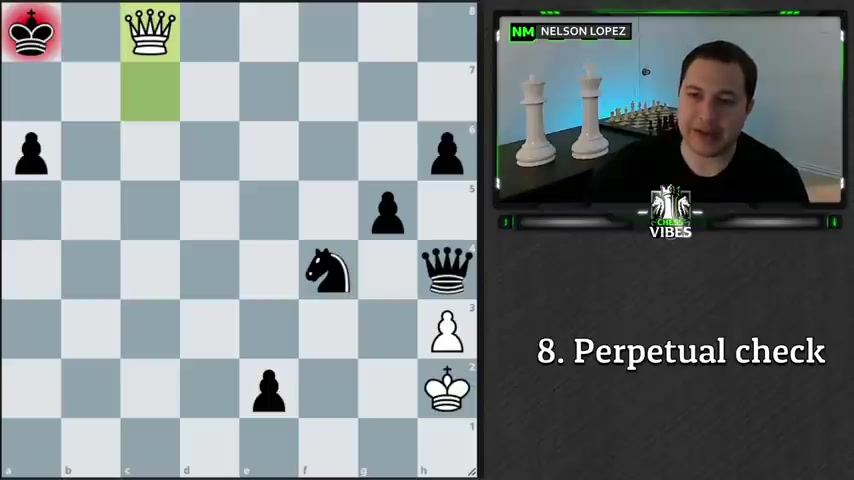
They don't have a lot of pieces that can block off from your queen , your queen checking them .
You can a lot of times get perpetual check .
It happens in a lot of different ways , but this is definitely something you need to keep in mind .
And if you are playing uh you know , the side with the extra material , you can't let your king be in a position like this .
You have to have at least one piece , maybe the night or the queen could have come back and uh blocked to give yourself some shield .
Uh so that you don't , you know , obviously get a perpetual check like this and just get a draw .
So keep those things in mind .
But queens are very good at perpetual checks at the end of the game , right ?
The next way we can use our queen is by pinning the H or the A ponds to the rooks in the corner .
Now , if that sounds really weird to you , don't worry , we're gonna look at an example .
But this is the Scandinavian , by the way , the Scandinavian is one of the openings that kind of goes against the principle of not bringing your queen out early .
Um But there's specific , you know , techniques for , for playing this opening and , and things that you can do with your queen to , to kind of keep it safe .
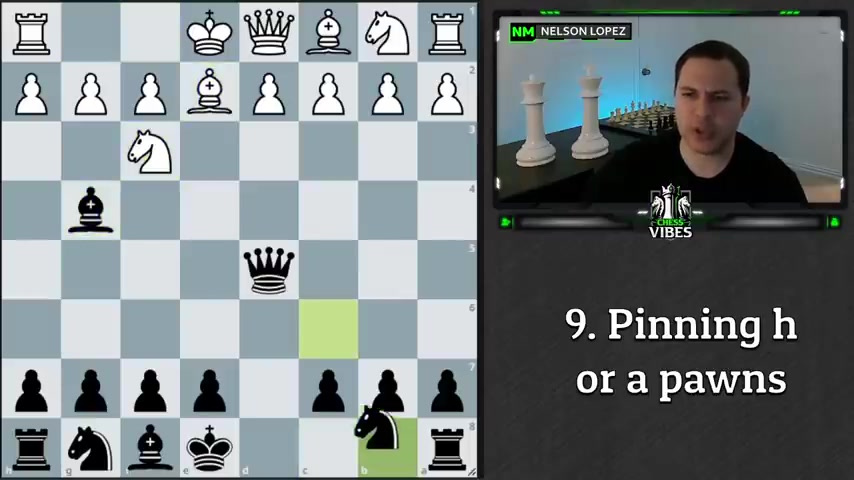
Um And one of those techniques is sometimes you swing it over to a five or in some cases , even to H five , which actually turned out to be pretty safe squares for the queen .
Uh And we'll look at that just in a second .
So bishop G four , bishop B 2 , 1963 .
OK ?
And at this point , white plays the move age three and they're obviously trying to take this bishop and um some , you know , we could just retreat , we could trade it for the , the night , which doesn't really make a lot of sense .
We're gonna lose some time , give up the bishop pair or my personal favorite .
We can play queen age five .
And what we're doing is creating like I said , a pin on this pond so that if it tries to take our bishop , we're gonna be taking the rook .
So we're winning the exchange .
Uh It's a very nice way to deal with this attack on your bishop .
If your queen is ever out in the center somewhere like this , you can do this on the H file or you can do the same thing over here if this night would have went to C three and we would have pinned it and the pawn .
Uh would you , sometimes you can do that here .
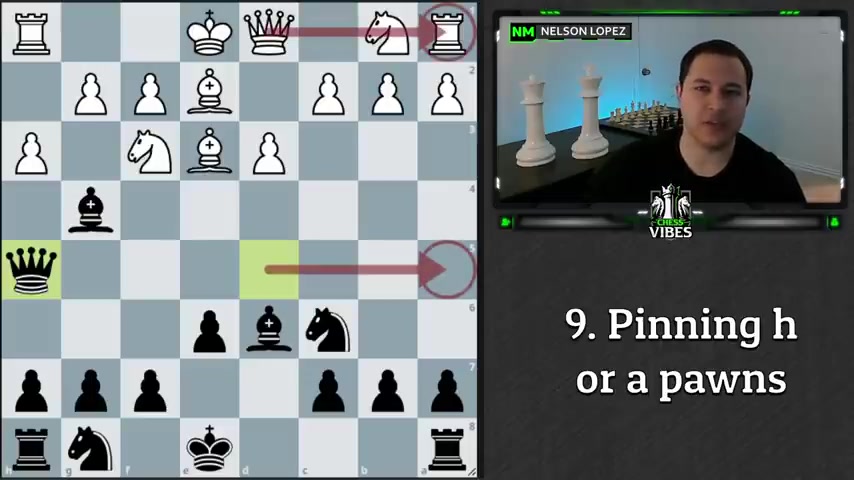
Now , uh on the uh a five , you have to be careful because the queen is defending the rook in this case , right ?
So that would , wouldn't work .
But if the queen was already up or whatever , you know , same idea can apply .
Um But in this case , white has to make a tough decision .
They can't take us if they want to actually threaten the bishop , they would have to castle because now there's no more pin .
But this is kind of risky .
Now , we can even just sacrifice if we want .
We've got a lot of threats .
White has to be very careful and I think this is pretty equal according to stockfish , but very dangerous position for white .
So uh the point going back is just remember , you can use your queen to create these little pins .
Um And it can be pretty annoying for your opponent , especially if they've never seen it before at the lower intermediate levels .
A lot of times they don't know how to respond to that .
So keep that in mind .
Like I said , it works on both sides .
And uh that's one of my favorite ways to deal with this attack on the bishop .
All right guys , that's nine ways .
You can use your queens more effectively in chess .
Let me know if I've left anything out or if you have questions , don't forget my tournament is coming very soon , so be on the lookout for those recaps .
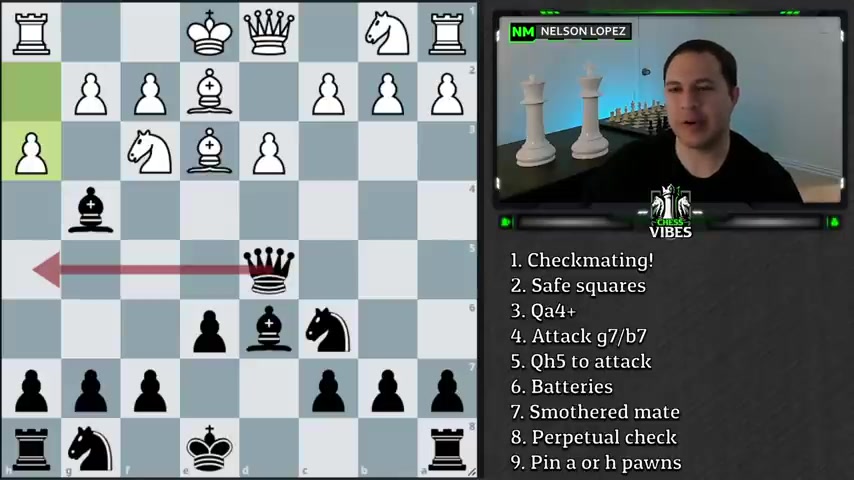
And , uh , I'm not sure if we'll do , uh , how to use your king or not .
There are a couple of things to keep in mind like the active king in the end game is , is good to be aware of , but I'm not sure if I can come up with a whole list of different ways to use your king .
But we'll see .
Um um , but I have to get ready for my tournament as and as well .
So it might just be jumping into the tournament recaps for the next video .
Um Anyway , thanks for watching .
Stay sharp , play smart , take care .
Are you looking for a way to reach a wider audience and get more views on your videos?
Our innovative video to text transcribing service can help you do just that.
We provide accurate transcriptions of your videos along with visual content that will help you attract new viewers and keep them engaged. Plus, our data analytics and ad campaign tools can help you monetize your content and maximize your revenue.
Let's partner up and take your video content to the next level!
Contact us today to learn more.